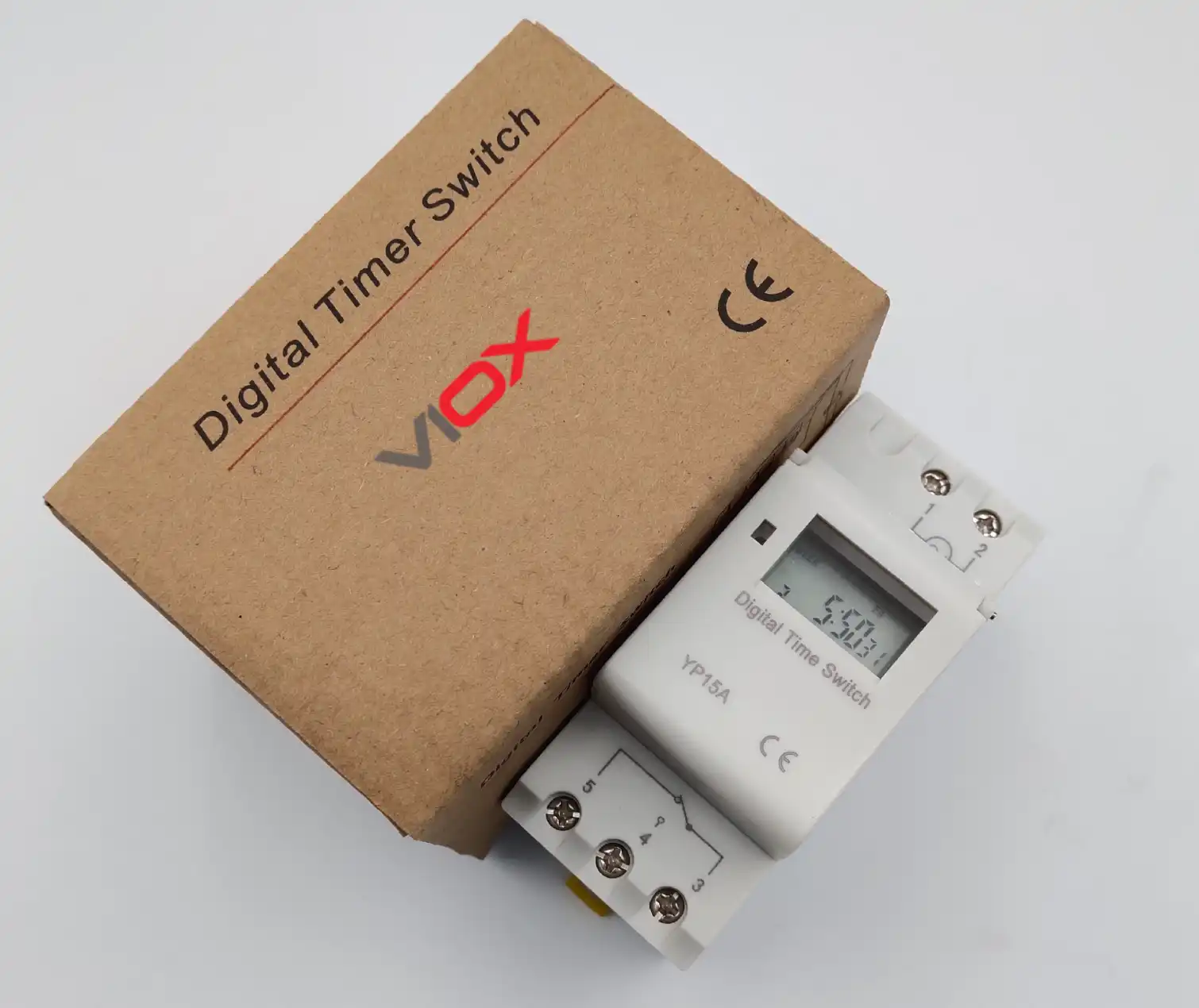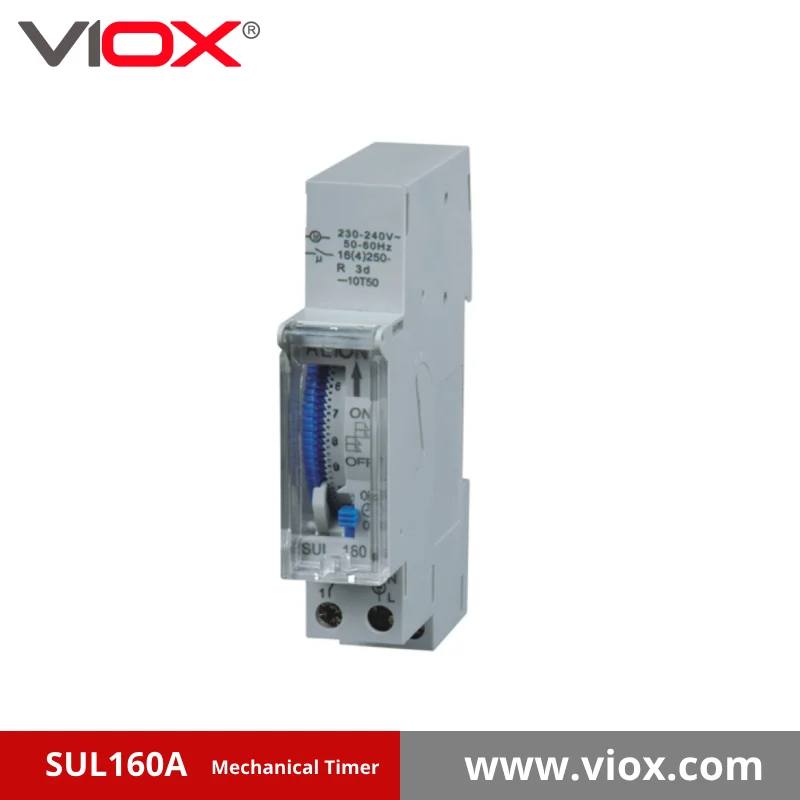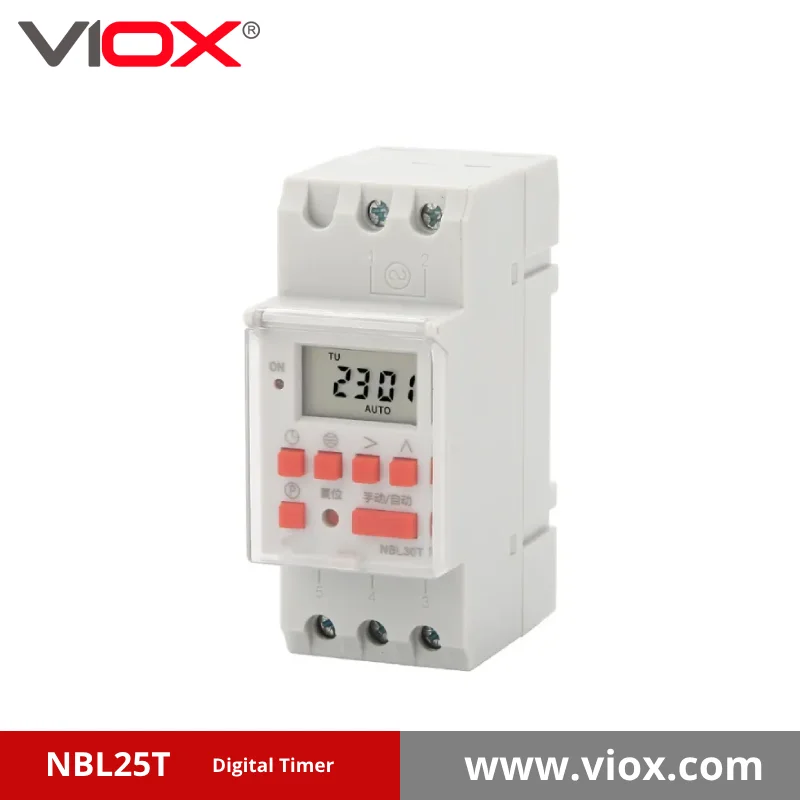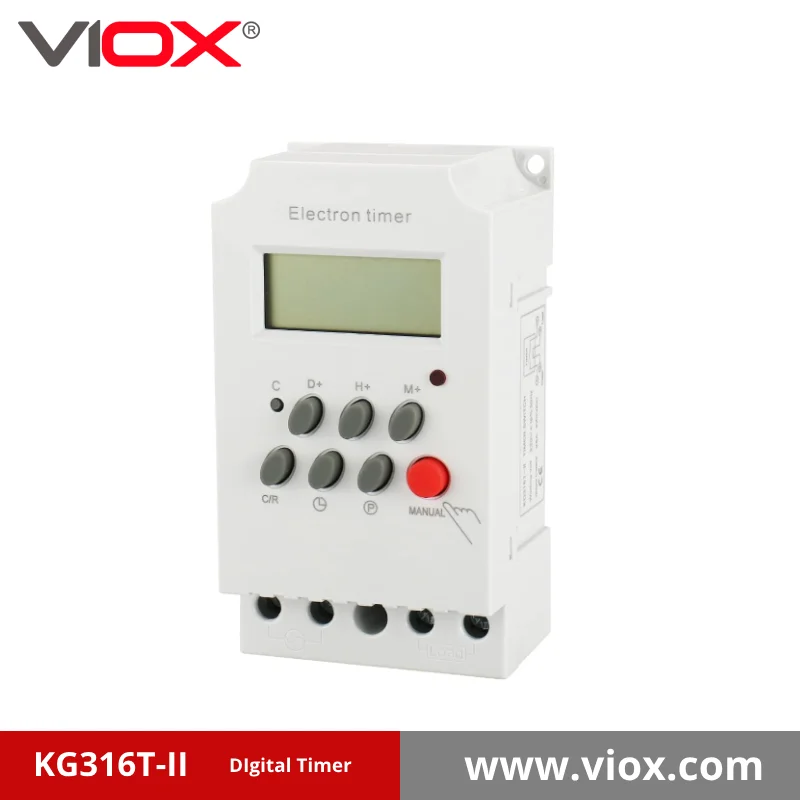สวิตช์ตั้งเวลาเป็นอุปกรณ์ควบคุมไฟฟ้าที่เปิดและปิดวงจรไฟฟ้าโดยอัตโนมัติตามเวลาที่กำหนดไว้ล่วงหน้า ทำให้ระบบแสงสว่าง, ความร้อน, ความเย็น และระบบไฟฟ้าอื่นๆ ทำงานโดยอัตโนมัติได้อย่างสะดวก. สวิตช์ตั้งเวลาช่วยประหยัดพลังงาน, ปรับปรุงความปลอดภัย และไม่จำเป็นต้องใช้งานอุปกรณ์ไฟฟ้าด้วยตนเอง ทำให้เป็นส่วนประกอบสำคัญในการใช้งานในที่พักอาศัย, เชิงพาณิชย์ และอุตสาหกรรมสมัยใหม่.
การทำความเข้าใจประเภท, ฟังก์ชัน และการใช้งานของสวิตช์ตั้งเวลาจะช่วยให้คุณเลือกโซลูชันระบบอัตโนมัติที่เหมาะสมกับความต้องการเฉพาะของคุณ พร้อมทั้งรับประกันความปลอดภัย, การปฏิบัติตามข้อกำหนด และประสิทธิภาพสูงสุด.
สวิตช์ตั้งเวลาคืออะไรและทำงานอย่างไร
เป็ สวิตช์ตั้งเวลา ใช้แทนสวิตช์ติดผนังแบบเดิมเพื่อให้การควบคุมวงจรไฟฟ้าเป็นไปโดยอัตโนมัติ อุปกรณ์เหล่านี้ทำงานโดยใช้กลไกการจับเวลาภายใน ไม่ว่าจะเป็นกลไกนาฬิกาแบบกลไก, ไมโครโปรเซสเซอร์ดิจิทัล หรือการเชื่อมต่ออัจฉริยะ เพื่อควบคุมว่าเมื่อใดที่กระแสไฟฟ้าจะไหลไปยังอุปกรณ์ที่เชื่อมต่อ.
ส่วนประกอบสำคัญของสวิตช์ตั้งเวลา:
- กลไกการจับเวลา: ควบคุมเวลาที่เกิดการสลับ (กลไก, ดิจิทัล หรืออัจฉริยะ)
- หน้าสัมผัสสวิตช์: หน้าสัมผัสที่ทนทานซึ่งรองรับโหลดไฟฟ้า
- ส่วนต่อประสานการควบคุม: วิธีการตั้งโปรแกรม (หน้าปัด, ปุ่ม หรือแอป)
- แหล่งจ่ายไฟ: แหล่งพลังงานภายในสำหรับฟังก์ชันการจับเวลา
- ขั้วต่อโหลด: จุดเชื่อมต่อสำหรับวงจรไฟฟ้า
ตัวจับเวลาเปลี่ยนประเภท:สมบูรณ์เปรียบเทียบนำทาง
สวิตช์ตั้งเวลาแบบกลไก
วิธีการทำงาน: สวิตช์ตั้งเวลาแบบกลไกใช้มอเตอร์ซิงโครนัสที่ขับเคลื่อนชุดเฟืองด้วยความเร็วคงที่ คล้ายกับกลไกนาฬิกา หมุดหรือแถบที่ถอดออกได้รอบหน้าปัดหมุนจะเป็นตัวกำหนดเวลาที่สวิตช์ทำงาน.
คุณสมบัติหลัก:
- ความแม่นยำ: ค่าเบี่ยงเบนโดยทั่วไป ±2-5 นาที
- การตั้งโปรแกรม: การปรับด้วยตนเองผ่านหน้าปัดหมุนพร้อมหมุดที่ถอดออกได้
- การใช้พลังงาน: 1-2 วัตต์ บางรุ่นทำงานได้โดยไม่ต้องใช้ไฟฟ้า
- Lifespan: อายุการใช้งานโดยทั่วไป 15-20 ปี
- ความจุในการรับน้ำหนัก: 15-30 แอมป์สำหรับโหลดความต้านทาน
การใช้งานที่ดีที่สุด: (Best Applications:)
- รอบการกรองปั๊มสระว่ายน้ำ
- การทำงานของอุปกรณ์กลางแจ้ง
- ตารางแสงสว่างประจำวันที่เรียบง่าย
- การใช้งานที่ไฟฟ้าดับเป็นเรื่องปกติ
สวิตช์ตั้งเวลาแบบดิจิทัล/อิเล็กทรอนิกส์
วิธีการทำงาน: สวิตช์ตั้งเวลาแบบดิจิทัลใช้ไมโครคอนโทรลเลอร์ที่มีออสซิลเลเตอร์คริสตัลควอตซ์เพื่อการจับเวลาที่แม่นยำ มีจอแสดงผล LCD/LED และอนุญาตให้ใช้โปรแกรมรายวันและรายสัปดาห์ได้หลายโปรแกรม.
คุณสมบัติหลัก:
- ความแม่นยำ: ความแม่นยำ ±2 วินาทีต่อวัน
- การตั้งโปรแกรม: โปรแกรมรายวัน/รายสัปดาห์หลายโปรแกรม (สูงสุด 16-32 รอบ ON/OFF)
- คุณสมบัติขั้นสูง: แบตเตอรี่สำรอง, โหมดวันหยุด, การแทนที่ด้วยตนเอง, ฟังก์ชันนับถอยหลัง
- การใช้พลังงาน: ประมาณ 2 วัตต์ต่อชั่วโมง
- แสดง: การอ่านค่าดิจิทัลที่ชัดเจนซึ่งแสดงเวลาและการตั้งค่าโปรแกรม
การใช้งานที่ดีที่สุด: (Best Applications:)
- ตารางแสงสว่างที่ซับซ้อน
- ระบบอัตโนมัติภายในอาคาร
- ไฟรักษาความปลอดภัยที่มีรูปแบบที่หลากหลาย
- ระบบอัตโนมัติของอาคารพาณิชย์
สวิตช์ตั้งเวลาแบบดาราศาสตร์
วิธีการทำงาน: ตัวตั้งเวลาดาราศาสตร์คำนวณเวลาพระอาทิตย์ขึ้นและตกโดยใช้อัลกอริทึมที่เก็บไว้ตามพิกัดทางภูมิศาสตร์ ปรับโดยอัตโนมัติสำหรับการเปลี่ยนแปลงตามฤดูกาลและเวลาออมแสง.
คุณสมบัติหลัก:
- การปรับอัตโนมัติ: ชดเชยการเปลี่ยนแปลงของแสงแดดตามฤดูกาลโดยอัตโนมัติ
- ความแม่นยำ: ±1 นาทีพร้อมความสามารถในการปรับตัวเอง
- การตั้งโปรแกรม: ต้องใช้ข้อมูลละติจูด/ลองจิจูดหรือการตรวจจับอัตโนมัติด้วย GPS
- การชดเชยตามฤดูกาล: ไม่จำเป็นต้องปรับด้วยตนเองตลอดทั้งปี
การใช้งานที่ดีที่สุด: (Best Applications:)
- ไฟรักษาความปลอดภัยกลางแจ้ง
- การส่องสว่างภูมิทัศน์
- ระบบไฟถนน
- ภายนอกอาคารที่ประหยัดพลังงาน
สวิตช์ตั้งเวลาแบบอัจฉริยะ/IoT
วิธีการทำงาน: สวิตช์ตั้งเวลาแบบอัจฉริยะเชื่อมต่อกับเครือข่ายบ้านผ่านโปรโตคอล Wi-Fi, Zigbee หรือ Z-Wave ทำให้สามารถควบคุมจากระยะไกลและคุณสมบัติระบบอัตโนมัติขั้นสูงผ่านแอปบนสมาร์ทโฟน.
คุณสมบัติหลัก:
- การเชื่อมต่อ: โปรโตคอล Wi-Fi, Zigbee, Z-Wave หรือ Bluetooth
- การบูรณาการ: เข้ากันได้กับ Alexa, Google Home, Apple HomeKit, Samsung SmartThings
- คุณสมบัติขั้นสูง: การควบคุมด้วยเสียง, Geofencing, การตรวจสอบพลังงาน, การเพิ่มประสิทธิภาพการเรียนรู้ของเครื่อง
- การใช้พลังงาน: 2-5 วัตต์ขึ้นอยู่กับการเชื่อมต่อ
การใช้งานที่ดีที่สุด: (Best Applications:)
- การรวมระบบบ้านอัจฉริยะ
- การตรวจสอบและควบคุมระยะไกล
- ระบบเพิ่มประสิทธิภาพพลังงาน
- ระบบอัตโนมัติที่อยู่อาศัยสมัยใหม่
ตารางเปรียบเทียบสวิตช์ตั้งเวลา
| คุณสมบัติ | เครื่องจักรกล | ดิจิทัล | ดาราศาสตร์ | อัจฉริยะ/IoT |
|---|---|---|---|---|
| ความแม่นยำ | ±2-5 นาที | ±2 วินาที/วัน | ±1 นาที | ±1 วินาที |
| โปรแกรมรายวัน | 1 | 1-16 | 1-16 | ไม่จำกัด |
| โปรแกรมรายสัปดาห์ | ไม่ | ใช่แล้ว | ใช่แล้ว | ใช่แล้ว |
| การปรับตามฤดูกาล | แบบแมนนวล | แบบแมนนวล | แบบอัตโนมัติ | แบบอัตโนมัติ |
| รีโมทคอนโทรล | ไม่ | ไม่ | จำกัด | ใช่แล้ว |
| ความซับซ้อนในการติดตั้ง | ต่ำ | ปานกลาง | ปานกลาง | สูง |
| การใช้พลังงาน | 1-2W | ~2W | 2-3W | 2-5W |
| อายุการใช้งานโดยทั่วไป | 15-20 ปี | 8-12 ปี | 10-15 ปี | 5-10 ปี |
| ช่วงราคา | $6-40 | $20-120 | $30-80 | $30-150 |
ฟังก์ชันและประโยชน์ของสวิตช์ตั้งเวลา
ฟังก์ชันหลัก
การตั้งเวลาอัตโนมัติ: สวิตช์ตั้งเวลาช่วยลดความจำเป็นในการใช้งานแบบแมนนวล โดยควบคุมวงจรไฟฟ้าโดยอัตโนมัติตามตารางเวลาที่กำหนดไว้ล่วงหน้า ซึ่งจะช่วยให้การทำงานสม่ำเสมอโดยไม่คำนึงถึงการเข้าใช้งานหรือความพร้อมของผู้ใช้.
การจัดการด้านพลังงาน: ด้วยการควบคุมเวลาที่อุปกรณ์ไฟฟ้าทำงาน สวิตช์ตั้งเวลาจะป้องกันการใช้พลังงานที่ไม่จำเป็นในช่วงเวลาที่ไม่มีคนอยู่ หรือเมื่อไม่จำเป็นต้องใช้อุปกรณ์.
การเพิ่มความปลอดภัย: ตารางเวลาแสงสว่างอัตโนมัติสร้างภาพลักษณ์ของการมีคนอยู่ ซึ่งเป็นการป้องปรามผู้บุกรุกที่อาจเกิดขึ้น รูปแบบแสงสว่างแบบสุ่มหรือหลากหลายให้ประโยชน์ด้านความปลอดภัยที่เพิ่มขึ้น.
การป้องกันอุปกรณ์: รอบการทำงานที่ควบคุมได้ช่วยยืดอายุการใช้งานของอุปกรณ์ไฟฟ้า โดยป้องกันการทำงานอย่างต่อเนื่อง และลดการสึกหรอของมอเตอร์ หลอดไฟ และส่วนประกอบอื่นๆ.
ประโยชน์หลักตามการใช้งาน
การใช้งานสำหรับที่พักอาศัย:
- 节能效果: ประหยัดค่าไฟฟ้าโดยอัตโนมัติ 4-91% เมื่อตั้งโปรแกรมอย่างเหมาะสม
- ความสะดวก: ลดการสลับแบบแมนนวลสำหรับกิจวัตรประจำวัน
- Security: รูปแบบแสงสว่างที่หลากหลายจำลองการมีคนอยู่ระหว่างวันหยุดพักผ่อน
- การลดต้นทุน: สวิตช์ตั้งเวลาสำหรับสระว่ายน้ำสามารถประหยัดค่าใช้จ่ายด้านพลังงานได้ 200-400 บาทต่อปี
การใช้งานเชิงพาณิชย์:
- รทำตามข้อตกล: ข้อกำหนดด้านประสิทธิภาพการใช้พลังงาน ASHRAE 90.1
- ประสิทธิภาพในการดำเนินงาน: ลดค่าสาธารณูปโภค 15-20% สำหรับอุปกรณ์ที่ควบคุม
- การลดการบำรุงรักษา: การทำงานตามกำหนดเวลาช่วยลดการสึกหรอของอุปกรณ์
- ความสม่ำเสมอของแบรนด์: การตั้งเวลาอัตโนมัติช่วยให้มั่นใจได้ถึงการนำเสนอแสงสว่างที่สม่ำเสมอ
การประยุกต์ใช้ในอุตสาหกรรม:
- การควบคุมกระบวนการ: การจับเวลาที่แม่นยำสำหรับกระบวนการผลิตและทางเคมี
- ระบบความปลอดภัย: ตารางการทดสอบอัตโนมัติสำหรับอุปกรณ์ฉุกเฉิน
- การเพิ่มประสิทธิภาพการใช้พลังงาน: ศักยภาพในการประหยัดพลังงานสูงสุดถึง 50% ในระบบแสงสว่างและ HVAC
- การควบคุมคุณภาพ: ตารางเวลาอัตโนมัติที่สม่ำเสมอช่วยให้มั่นใจได้ถึงกระบวนการที่เชื่อถือได้
คู่มือการใช้งานสวิตช์ตั้งเวลา
การใช้งานสำหรับที่พักอาศัย
ระบบควบคุมแสงสว่าง
ระบบอัตโนมัติภายในอาคาร
- ไฟรักษาความปลอดภัย: ป้องปรามผู้บุกรุกด้วยรูปแบบแสงสว่างที่หลากหลาย
- การตั้งเวลาเพื่อความสะดวก: การทำงานอัตโนมัติสำหรับกิจวัตรประจำวัน
- การจัดการด้านพลังงาน: ป้องกันไม่ให้เปิดไฟทิ้งไว้โดยไม่จำเป็น
- ประเภทที่แนะนำ: ตัวตั้งเวลาแบบดิจิตอลที่ตั้งโปรแกรมได้สำหรับตารางเวลาที่ซับซ้อน
ไฟส่องสว่างภายนอกอาคาร
- การส่องสว่างภูมิทัศน์: การทำงานอัตโนมัติตั้งแต่พลบค่ำถึงรุ่งเช้า
- ไฟรักษาความปลอดภัย: การสำรองข้อมูลที่เปิดใช้งานด้วยการเคลื่อนไหวพร้อมการแทนที่ตัวตั้งเวลา
- ของประดับตกแต่งวันหยุด: การตั้งเวลาตามฤดูกาลด้วยการตั้งโปรแกรมที่ง่ายดาย
- ประเภทที่แนะนำ: ตัวตั้งเวลาทางดาราศาสตร์สำหรับการปรับตามฤดูกาลโดยอัตโนมัติ
อุปกรณ์สระว่ายน้ำและสปา
ระบบกรอง
- การทำงานที่เหมาะสมที่สุด: 6-8 ชั่วโมงต่อวันเพื่อการบำรุงรักษาน้ำที่มีคุณภาพ
- ประสิทธิภาพการใช้พลังงาน: ป้องกันการทำงานของปั๊มตลอด 24 ชั่วโมงทุกวัน
- การป้องกันอุปกรณ์: รอบการควบคุมช่วยยืดอายุการใช้งานของปั๊ม
- การประหยัดต้นทุน: ลดค่าใช้จ่ายด้านพลังงาน 200-400 บาทต่อปี
ระบบทำความร้อนและสารเคมี
- การจับเวลาที่แม่นยำ: ประสานการทำความร้อนกับรอบการกรอง
- การให้สารเคมี: การทำงานของระบบเคมีอัตโนมัติ
- คุณสมบัติด้านความปลอดภัย: ป้องกันความร้อนสูงเกินไปและการให้สารเคมีมากเกินไป
HVAC และการทำความร้อนน้ำ
การควบคุมเครื่องทำน้ำอุ่น
- การจัดการความต้องการพลังงาน: ทำความร้อนในช่วงนอกเวลาเร่งด่วน
- ประสิทธิภาพการใช้พลังงาน: ลดการสูญเสียพลังงานขณะสแตนด์บายในช่วงที่มีความต้องการต่ำ
- การเพิ่มประสิทธิภาพด้านต้นทุน: ใช้ประโยชน์จากอัตราค่าไฟฟ้าตามช่วงเวลา
ระบบระบายอากาศ
- พัดลมระบายอากาศในห้องน้ำ: การทำงานอัตโนมัติเพื่อควบคุมความชื้น
- การระบายอากาศในห้องใต้หลังคา: ตารางการทำงานตามอุณหภูมิ
- การจัดการคุณภาพอากาศ: การหมุนเวียนอากาศอย่างสม่ำเสมอ
การใช้งานเชิงพาณิชย์
ระบบอัตโนมัติสำหรับอาคารสำนักงาน
ระบบแสงสว่าง
- การควบคุมลานจอดรถ: ตัวจับเวลาดาราศาสตร์พร้อมการผสานรวมโฟโตเซลล์
- ระบบไฟส่องสว่างภายใน: ระบบอัตโนมัติสำหรับบันได, ทางเดิน และห้องประชุม
- การปฏิบัติตามข้อกำหนดด้านพลังงาน: เป็นไปตามข้อกำหนดของรหัส ASHRAE 90.1
- ประโยชน์ด้านต้นทุน: ลดค่าใช้จ่ายด้านพลังงานแสงสว่างลง 15-20%
การประสานงาน HVAC
- การควบคุมตามการใช้งาน: ใช้งานระบบเฉพาะในช่วงเวลาทำการ
- การปรับลดอุณหภูมิ: การปรับอุณหภูมิอัตโนมัติสำหรับช่วงเวลาที่ไม่มีคนอยู่
- การจัดการอากาศบริสุทธิ์: การระบายอากาศตามกำหนดเวลาเพื่อคุณภาพอากาศภายในอาคาร
ร้านค้าปลีกและป้าย
ไฟส่องสว่างสำหรับแสดงสินค้า
- หน้าต่างหน้าร้าน: แสงสว่างที่น่าดึงดูดในตอนเย็น
- การควบคุมป้ายโฆษณา: ตารางการเปิดไฟป้ายอัตโนมัติ
- ไฟส่องสว่างเพื่อการส่งเสริมการขาย: การตั้งโปรแกรมสำหรับฤดูกาลและกิจกรรมพิเศษ
ประสิทธิภาพในการดำเนินงาน
- การจัดการด้านพลังงาน: การผสมผสานระหว่างตัวจับเวลาและโฟโตเซลล์เพื่อการทำงานที่เหมาะสมที่สุด
- การลดการบำรุงรักษา: การทำงานตามกำหนดเวลาช่วยลดความถี่ในการเปลี่ยนหลอดไฟ
- ความสม่ำเสมอของแบรนด์: การนำเสนอแสงสว่างอัตโนมัติที่เชื่อถือได้
การประยุกต์ใช้ในอุตสาหกรรม
ระบบการผลิต
อุปกรณ์การผลิต
- รอบการอุ่นเครื่อง: การเตรียมเครื่องจักรอัตโนมัติ
- ระบบสายพานลำเลียง: การจับเวลาที่แม่นยำสำหรับสายการผลิต
- การควบคุมคุณภาพ: ตารางการทดสอบอัตโนมัติที่สม่ำเสมอ
การควบคุมกระบวนการ
- การให้สารเคมี: การจับเวลาที่แม่นยำสำหรับกระบวนการบำบัด
- ระบบความปลอดภัย: การทดสอบอุปกรณ์ฉุกเฉินอัตโนมัติ
- การควบคุมสิ่งแวดล้อม: การจัดการการระบายอากาศและอุณหภูมิ
การจัดการด้านพลังงาน
การควบคุมความต้องการพลังงาน
- การจัดตารางโหลด: ประสานงานการทำงานของอุปกรณ์ที่ต้องการพลังงานสูง
- การลดความต้องการพลังงานสูงสุด: ลดค่าใช้จ่ายด้านความต้องการพลังงานจากสาธารณูปโภค
- การปรับปรุงตัวประกอบกำลังไฟฟ้า: การสลับตัวเก็บประจุอัตโนมัติ
การเพิ่มประสิทธิภาพ
- การหมุนเวียนอุปกรณ์: ป้องกันการทำงานต่อเนื่องที่ไม่จำเป็น
- การจัดตารางการบำรุงรักษา: รอบการหล่อลื่นและการทำความสะอาดอัตโนมัติ
- การตรวจสอบพลังงาน: ติดตามและเพิ่มประสิทธิภาพรูปแบบการบริโภค
คู่มือการเลือกสวิตช์ตั้งเวลา
ข้อกำหนดด้านความสามารถในการรับโหลด
โหลดความต้านทาน (เครื่องทำความร้อน, หลอดไส้)
- ที่อยู่อาศัย: ความสามารถในการรับโหลด 15-20 แอมป์ โดยทั่วไป
- โฆษณา: ต้องการความสามารถในการรับโหลด 20-30 แอมป์
- รองอุตสาหกรรม: ต้องการความสามารถในการรับโหลด 30+ แอมป์ สำหรับอุปกรณ์หนัก
โหลดเหนี่ยวนำ (มอเตอร์, หลอดฟลูออเรสเซนต์)
- โหลดมอเตอร์: ต้องการความสามารถในการรับโหลดสูงกว่าพิกัดที่ระบุ 25-40%
- หลอดฟลูออเรสเซนต์: ตรวจสอบความเข้ากันได้ของบัลลาสต์และกระแสไหลเข้า
- หลอดไฟ LED: ตรวจสอบข้อกำหนดโหลดขั้นต่ำและความเข้ากันได้
โหลดแบบ Capacitive (อุปกรณ์อิเล็กทรอนิกส์)
- ไดรเวอร์ LED: ตรวจสอบข้อกำหนดโหลดขั้นต่ำ
- บัลลาสต์อิเล็กทรอนิกส์: ตรวจสอบความเข้ากันได้กับการสลับตัวจับเวลา
- แหล่งจ่ายไฟ: พิจารณาคุณลักษณะกระแสไหลเข้า
การพิจารณาด้านสิ่งแวดล้อม
การใช้งานภายในอาคาร
- เงื่อนไขมาตรฐาน: การป้องกัน NEMA 1 หรือ IP20 เพียงพอ
- สูดดมเข้าไปเย็นชื่นสภาพแวดล้อม: ระดับ IP44 สำหรับห้องน้ำและห้องครัว
- อุณหภูมิที่รุนแรง: ตรวจสอบช่วงอุณหภูมิการทำงาน
การใช้งานกลางแจ้ง
- การป้องกันสภาพอากาศ: ต้องมีระดับ IP65 ขั้นต่ำ
- สภาวะสุดขั้ว: IP67 สำหรับการป้องกันการแช่ชั่วคราว
- สภาพแวดล้อมที่กัดกร่อน: สแตนเลสหรือวัสดุที่ทนต่อการกัดกร่อน
ข้อกำหนดด้านคุณสมบัติ
การใช้งานพื้นฐาน
- การตั้งเวลาอย่างง่าย: ตัวจับเวลาแบบกลไกสำหรับการควบคุมเปิด/ปิดที่ตรงไปตรงมา
- โปรแกรมที่จำกัด: รอบรายวันเดียวก็เพียงพอ
- คำนึงถึงต้นทุน: ตัวจับเวลาแบบกลไกให้ความคุ้มค่าสูงสุด
แอปพลิเคชั่นขั้นสูง
- หลายโปรแกรม: ตัวจับเวลาแบบดิจิตอลที่มีโปรแกรมรายวัน 16+ โปรแกรม
- การปรับตามฤดูกาล: ตัวจับเวลาดาราศาสตร์สำหรับการเปลี่ยนแปลงอัตโนมัติ
- รีโมทคอนโทรล: ตัวจับเวลาอัจฉริยะสำหรับการทำงานผ่านแอป
แนวทางการติดตั้งและความปลอดภัย
ข้อกำหนดด้านความปลอดภัยก่อนการติดตั้ง
⚠️ความปลอดภัยแจ้งเตือน: ปิดไฟที่เซอร์กิตเบรกเกอร์เสมอก่อนทำการติดตั้ง ใช้เครื่องทดสอบแรงดันไฟฟ้าเพื่อตรวจสอบว่าปิดไฟแล้ว และทดสอบเครื่องทดสอบแรงดันไฟฟ้ากับวงจรที่มีไฟอยู่เพื่อให้แน่ใจว่าทำงานได้อย่างถูกต้อง.
ขั้นตอนด้านความปลอดภัยที่จำเป็น:
- การตัดการเชื่อมต่อไฟฟ้า: ปิดไฟที่เซอร์กิตเบรกเกอร์
- การตรวจสอบแรงดันไฟฟ้า: ทดสอบด้วยมัลติมิเตอร์ดิจิตอลหรือเครื่องทดสอบแรงดันไฟฟ้า
- การทดสอบอุปกรณ์: ตรวจสอบอุปกรณ์ทดสอบกับวงจรที่มีไฟอยู่
- การระบุสายไฟ: ติดป้ายกำกับสายไฟทั้งหมด (สายไฟ, โหลด, นิวทรัล, กราวด์)
- เอกสารอ้างอิง: ถ่ายภาพสายไฟที่มีอยู่
ขั้นตอนการติดตั้ง
ขั้นตอนที่ 1: การเตรียมการ
- ถอดสวิตช์ที่มีอยู่ออกและตรวจสอบสภาพสายไฟ
- ตรวจสอบว่าขนาดสายไฟตรงกับข้อกำหนดของสวิตช์จับเวลา
- ตรวจสอบความลึกของกล่องและความยาวของสายไฟที่เพียงพอ
ขั้นตอนที่ 2: การเชื่อมต่อสายไฟ
- ต่อสายดินเข้ากับขั้วต่อสายดินของสวิตช์จับเวลา
- ต่อสายนิวทรัลหากประเภทตัวจับเวลาต้องการ
- ต่อสายไฟเข้ากับขั้วต่อสายไฟ (โดยปกติจะเป็นสีดำ)
- ต่อสายโหลดเข้ากับขั้วต่อโหลด (โดยปกติจะเป็นสีแดง)
ขั้นตอนที่ 3: การติดตั้งเสร็จสมบูรณ์
- พับสายไฟอย่างระมัดระวังลงในกล่องไฟฟ้า
- ยึดสวิตช์จับเวลาเข้ากับหูยึด
- ติดตั้งแผ่นปิดและคืนพลังงาน
- ทดสอบการทำงานและการตั้งค่าโปรแกรม
ข้อกำหนดการปฏิบัติตามรหัส
ประมวลกฎหมายไฟฟ้าแห่งชาติ (NEC) 2023
- ข้อกำหนดเกี่ยวกับสายนิวทรัล: NEC 404.2(C) กำหนดให้ต้องมีตัวนำนิวทรัลที่ตำแหน่งสวิตช์ในห้องน้ำ ทางเดิน บันได และห้องที่อยู่อาศัยได้
- การป้องกัน GFCI: จำเป็นสำหรับสวิตช์ตั้งเวลาในบริเวณที่เปียกชื้น
- การต่อสายดินที่ถูกต้อง: สวิตช์ตั้งเวลาทั้งหมดต้องต่อสายดินอย่างถูกต้อง
การเปลี่ยนแปลงรหัสท้องถิ่น
- ข้อกำหนดด้านใบอนุญาต: ตรวจสอบข้อกำหนดในพื้นที่สำหรับการทำงานเกี่ยวกับไฟฟ้า
- ความต้องการในการตรวจสอบ: เขตอำนาจศาลบางแห่งกำหนดให้ต้องมีการตรวจสอบการติดตั้งสวิตช์ตั้งเวลา
- การติดตั้งโดยมืออาชีพ: อาจจำเป็นสำหรับการติดตั้งที่ซับซ้อน
การแก้ไขปัญหาสวิตช์ตั้งเวลาทั่วไป
กระบวนการแก้ไขปัญหา 7 ขั้นตอน
ขั้นตอนที่ 1: ตรวจสอบการตั้งโปรแกรม
- ตรวจสอบการตั้งค่าวันและเวลาที่ถูกต้อง
- ตรวจสอบให้แน่ใจว่ากลุ่มเวลาที่ไม่ได้ใช้แสดง “–:–“
- ตรวจสอบการตั้งค่า AM/PM บนจอแสดงผล 12 ชั่วโมง
ขั้นตอนที่ 2: ตรวจสอบโหมดการทำงาน
- ยืนยันว่าสวิตช์อยู่ในโหมด “AUTO” ไม่ใช่ “MANUAL”
- ทดสอบฟังก์ชันการแทนที่ด้วยตนเอง
- ตรวจสอบการตั้งค่าเปิด/ปิดใช้งานโปรแกรม
ขั้นตอนที่ 3: ตรวจสอบแหล่งจ่ายไฟ
- ตรวจสอบแรงดันไฟฟ้าที่เหมาะสมที่ขั้วต่อของตัวตั้งเวลา
- ตรวจสอบการเชื่อมต่อสายไฟที่แน่นหนา
- ทดสอบแรงดันไฟฟ้าตกภายใต้โหลด
ขั้นตอนที่ 4: ทดสอบส่วนประกอบภายใน
- ตรวจสอบและเปลี่ยนฟิวส์ที่ขาด (โดยทั่วไปมีพิกัด 0.1A-0.3A)
- เปลี่ยนแบตเตอรี่สำรองหากมี
- ตรวจสอบการทำงานและความคมชัดของจอแสดงผล
ขั้นตอนที่ 5: ความเข้ากันได้ของโหลด
- ตรวจสอบให้แน่ใจว่าโหลดไม่เกินความจุของตัวตั้งเวลา
- ตรวจสอบปัญหาความเข้ากันได้ของ LED
- ตรวจสอบข้อกำหนดโหลดขั้นต่ำ
ขั้นตอนที่ 6: ปัจจัยด้านสิ่งแวดล้อม
- ตรวจสอบการรั่วซึมของความชื้นในการติดตั้งภายนอกอาคาร
- ตรวจสอบช่วงอุณหภูมิการทำงาน
- ตรวจสอบการกัดกร่อนหรือความเสียหาย
ขั้นตอนที่ 7: การปรึกษาผู้เชี่ยวชาญ
- ติดต่อฝ่ายสนับสนุนด้านเทคนิคของผู้ผลิต
- พิจารณาการตรวจสอบทางไฟฟ้าโดยผู้เชี่ยวชาญ
- วางแผนสำหรับการเปลี่ยนตัวตั้งเวลาหากจำเป็น
ปัญหาทั่วไปและวิธีแก้ไข
| ปัญหา | น่าจะเพราะ | ทางออก |
|---|---|---|
| ตัวตั้งเวลาไม่สลับตามเวลาที่กำหนด | การตั้งโปรแกรมไม่ถูกต้อง | ตรวจสอบเวลา วันที่ และการตั้งค่าโปรแกรม |
| การสูญเสียการตั้งค่าหลังจากไฟฟ้าดับ | แบตเตอรี่สำรองล้มเหลว | เปลี่ยนแบตเตอรี่หรืออัปเกรดเป็นตัวตั้งเวลาหน่วยความจำแบบไม่ลบเลือน |
| ไฟกะพริบเมื่อใช้โหลด LED | ประเภทตัวตั้งเวลาไม่เข้ากัน | ใช้ตัวตั้งเวลาที่เข้ากันได้กับ LED ที่มีโหลดขั้นต่ำที่เหมาะสม |
| จอแสดงผลตัวตั้งเวลาดับหรือผิดปกติ | ปัญหาแหล่งจ่ายไฟ | ตรวจสอบแหล่งจ่ายไฟและสายไฟ |
| การแทนที่ด้วยตนเองไม่ทำงาน | หน้าสัมผัสสวิตช์ผิดพลาด | จำเป็นต้องเปลี่ยนโดยผู้เชี่ยวชาญ |
| การทำงานที่ไม่สอดคล้องกัน | การสึกหรอทางกล | เปลี่ยนด้วยสวิตช์ตั้งเวลาใหม่ |
เคล็ดลับจากผู้เชี่ยวชาญเพื่อความสำเร็จในการใช้สวิตช์ตั้งเวลา
แนวทางปฏิบัติที่ดีที่สุดในการตั้งโปรแกรม
เคล็ดลับที่ 1: วางแผนตารางเวลาของคุณ
กำหนดเวลาการทำงานที่ต้องการก่อนการตั้งโปรแกรม พิจารณาการเปลี่ยนแปลงตามฤดูกาลและเวลาออมแสง คำนึงถึงระยะเวลาการวอร์มอัพและคูลดาวน์ของอุปกรณ์.
เคล็ดลับที่ 2: ใช้การป้องกันการทับซ้อน
หลีกเลี่ยงความขัดแย้งในการตั้งโปรแกรมระหว่างตัวตั้งเวลาต่างๆ ตรวจสอบให้แน่ใจว่ามีเวลาเพียงพอระหว่างการสลับการทำงาน พิจารณาคุณลักษณะการเริ่มต้นโหลด.
เคล็ดลับที่ 3: ทดสอบอย่างละเอียด
เรียกใช้รอบโปรแกรมทั้งหมดก่อนที่จะพึ่งพาระบบอัตโนมัติ ตรวจสอบการทำงานระหว่างไฟฟ้าดับหากติดตั้งแบตเตอรี่สำรอง จัดทำเอกสารการตั้งค่าโปรแกรมเพื่อใช้อ้างอิงในอนาคต.
กลยุทธ์การเพิ่มประสิทธิภาพพลังงาน
เคล็ดลับที่ 4: ประสานงานกับอัตราค่าไฟฟ้า
ตั้งโปรแกรมอุปกรณ์ที่ใช้พลังงานสูงในช่วงเวลาที่ไม่ใช่ช่วงพีค ใช้ประโยชน์จากอัตราค่าไฟฟ้าตามช่วงเวลา พิจารณาค่าความต้องการ (demand charges) สำหรับการติดตั้งเชิงพาณิชย์.
เคล็ดลับที่ 5: บูรณาการกับการควบคุมอื่นๆ
รวมตัวจับเวลากับโฟโตเซลล์เพื่อให้แสงสว่างกลางแจ้งเหมาะสมที่สุด ใช้กับเซ็นเซอร์ตรวจจับความเคลื่อนไหวเพื่อประสิทธิภาพสูงสุด ประสานงานกับระบบอัตโนมัติของอาคาร.
การบำรุงรักษาและอายุการใช้งาน
เคล็ดลับที่ 6: การตรวจสอบเป็นประจำ
ตรวจสอบความถูกต้องของการตั้งโปรแกรมตามฤดูกาล ตรวจสอบสภาพทางกายภาพเป็นประจำทุกปี เปลี่ยนแบตเตอรี่ในระบบสำรองตามความจำเป็น.
เคล็ดลับที่ 7: การบูรณาการอย่างมืออาชีพ
ปรึกษาช่างไฟฟ้าสำหรับการติดตั้งที่ซับซ้อน พิจารณาการบูรณาการระบบสำหรับตัวจับเวลาหลายตัว วางแผนสำหรับการขยายและการอัปเกรดในอนาคต.
คำถามที่ถูกถามบ่อย
คำถามเกี่ยวกับการใช้งานพื้นฐาน
ถาม: สวิตช์ตั้งเวลาแบบกลไกและแบบดิจิทัลแตกต่างกันอย่างไร
ตอบ: สวิตช์ตั้งเวลาแบบกลไกใช้กลไกนาฬิกาที่มีหมุดทางกายภาพสำหรับการตั้งโปรแกรม ให้ความเรียบง่ายและอายุการใช้งานยาวนาน (15-20 ปี) แต่มีความแม่นยำจำกัด (±2-5 นาที) สวิตช์ตั้งเวลาแบบดิจิทัลใช้ไมโครโปรเซสเซอร์ที่มีการจับเวลาควอตซ์ที่แม่นยำ (±2 วินาที/วัน) และอนุญาตให้มีโปรแกรมที่ซับซ้อนหลายโปรแกรม แต่มีอายุการใช้งานสั้นกว่า (8-12 ปี).
ถาม: ฉันจะรู้ได้อย่างไรว่าสวิตช์ตั้งเวลาของฉันเข้ากันได้กับไฟ LED
ตอบ: ตรวจสอบข้อกำหนดของตัวจับเวลาสำหรับความเข้ากันได้ของ LED และข้อกำหนดโหลดขั้นต่ำ ตัวจับเวลาเก่าจำนวนมากต้องการโหลดขั้นต่ำที่ไฟ LED ไม่สามารถให้ได้ ทำให้เกิดการกะพริบหรือล้มเหลวในการทำงาน มองหาตัวจับเวลาที่ได้รับการจัดอันดับเฉพาะสำหรับโหลด LED หรือตัวจับเวลาที่มีความเข้ากันได้กับแรงดันไฟฟ้าต่ำแบบอิเล็กทรอนิกส์.
ถาม: ฉันสามารถติดตั้งสวิตช์ตั้งเวลาเองได้หรือไม่ หรือฉันต้องใช้ช่างไฟฟ้า
ตอบ: การเปลี่ยนสวิตช์ตั้งเวลาอย่างง่ายโดยทั่วไปไม่จำเป็นต้องใช้ช่างไฟฟ้า หากคุณคุ้นเคยกับงานไฟฟ้าพื้นฐาน อย่างไรก็ตาม ขอแนะนำให้ติดตั้งโดยผู้เชี่ยวชาญสำหรับวงจรใหม่ การกำหนดค่าสามทางที่ซับซ้อน การติดตั้งกลางแจ้ง หรือเมื่อรหัสท้องถิ่นกำหนดให้ต้องมีใบอนุญาตและการตรวจสอบ.
คำถามทางเทคนิคและความปลอดภัย
ถาม: ข้อกำหนดสายไฟที่เป็นกลางหมายถึงอะไรสำหรับสวิตช์ตั้งเวลา
ตอบ: ประมวลกฎหมายไฟฟ้าแห่งชาติปี 2023 กำหนดให้มีสายไฟที่เป็นกลางที่ตำแหน่งสวิตช์ในห้องน้ำ ทางเดิน บันได และห้องที่อยู่อาศัย ตัวจับเวลาอัจฉริยะและดิจิทัลจำนวนมากต้องการการเชื่อมต่อที่เป็นกลางเพื่อให้ทำงานได้อย่างถูกต้อง โดยเฉพาะอย่างยิ่งกับโหลด LED หากไม่มีสายไฟที่เป็นกลาง คุณอาจต้องติดตั้งสายเคเบิลใหม่โดยผู้เชี่ยวชาญ.
ถาม: สวิตช์ตั้งเวลาทางดาราศาสตร์รู้ได้อย่างไรว่าจะเปิดและปิดไฟเมื่อใด
ตอบ: ตัวจับเวลาทางดาราศาสตร์มีอัลกอริธึมคอมพิวเตอร์ที่คำนวณเวลาพระอาทิตย์ขึ้นและตกตามตำแหน่งทางภูมิศาสตร์ของคุณ (ละติจูดและลองจิจูด) พวกเขาปรับโดยอัตโนมัติตลอดทั้งปีสำหรับการเปลี่ยนแปลงตามฤดูกาลและเวลาออมแสง โดยไม่จำเป็นต้องตั้งโปรแกรมใหม่ด้วยตนเอง.
ถาม: ฉันควรทำอย่างไรหากสวิตช์ตั้งเวลาของฉันหยุดทำงานหลังจากไฟฟ้าดับ
ตอบ: ขั้นแรก ตรวจสอบว่าจอแสดงผลแสดงเวลาที่ถูกต้องหรือไม่ และตั้งโปรแกรมใหม่หากจำเป็น หากตัวจับเวลามีแบตเตอรี่สำรอง ให้เปลี่ยนแบตเตอรี่ สำหรับตัวจับเวลาที่ไม่มีแบตเตอรี่สำรอง ให้ตั้งโปรแกรมการตั้งค่าทั้งหมดใหม่ หากปัญหายังคงอยู่ ส่วนประกอบภายในอาจได้รับความเสียหายจากไฟกระชาก ซึ่งต้องเปลี่ยนใหม่.
คำถามเกี่ยวกับการเลือกและการใช้งาน
ถาม: สวิตช์ตั้งเวลาประเภทใดดีที่สุดสำหรับอุปกรณ์สระว่ายน้ำ
ตอบ: สำหรับปั๊มสระว่ายน้ำและระบบกรอง มักนิยมใช้สวิตช์ตั้งเวลาแบบกลไกเนื่องจากมีความน่าเชื่อถือ ไม่ต้องใช้สายไฟที่เป็นกลาง และยังคงทำงานต่อไปได้ในระหว่างที่ไฟฟ้าดับ ตั้งโปรแกรมสำหรับการทำงาน 6-8 ชั่วโมงต่อวัน โดยทั่วไปในช่วงเวลาที่ไม่ใช่ช่วงพีคของไฟฟ้าเพื่อลดค่าใช้จ่าย.
ถาม: ฉันสามารถใช้สวิตช์ตั้งเวลากับการตั้งค่าไฟสามทางได้หรือไม่
ตอบ: ได้ แต่ต้องใช้สวิตช์ตั้งเวลาสามทางพิเศษ (เช่น Intermatic ST01) หรือติดตั้งที่ปลายแหล่งพลังงานของวงจร สวิตช์ตั้งเวลามาตรฐานไม่ทำงานในการกำหนดค่าสามทาง พิจารณาปรึกษาช่างไฟฟ้าเพื่อการติดตั้งที่เหมาะสม.
ถาม: ฉันสามารถประหยัดพลังงานได้เท่าไรด้วยสวิตช์ตั้งเวลา
ตอบ: การใช้งานในที่พักอาศัยโดยทั่วไปจะเห็นการประหยัดไฟฟ้าโดยอัตโนมัติ 4-9% ด้วยการตั้งโปรแกรมที่เหมาะสม สวิตช์ตั้งเวลาสระว่ายน้ำสามารถประหยัดได้ $200-400 ต่อปี อาคารพาณิชย์สามารถลดต้นทุนอุปกรณ์ควบคุมได้ 15-20% การประหยัดที่แท้จริงขึ้นอยู่กับรูปแบบการใช้งานปัจจุบันและอัตราค่าไฟฟ้า.
—
พร้อมที่จะทำให้ระบบไฟฟ้าของคุณเป็นอัตโนมัติแล้วหรือยัง สวิตช์ตั้งเวลาให้ระบบอัตโนมัติที่เชื่อถือได้และคุ้มค่า ซึ่งช่วยประหยัดพลังงาน ปรับปรุงความปลอดภัย และลดความซับซ้อนของกิจวัตรประจำวัน เลือกประเภทที่เหมาะสมสำหรับการใช้งานของคุณ ปฏิบัติตามขั้นตอนการติดตั้งและความปลอดภัยที่เหมาะสม และเพลิดเพลินไปกับประโยชน์ของการควบคุมไฟฟ้าอัจฉริยะ สำหรับการติดตั้งที่ซับซ้อนหรือเมื่อมีข้อสงสัยเกี่ยวกับงานไฟฟ้า ให้ปรึกษาช่างไฟฟ้าที่มีคุณสมบัติเหมาะสมเพื่อให้แน่ใจว่าการทำงานมีความปลอดภัยและเป็นไปตามข้อกำหนด.
เกี่ยวข้องกัน
วิธีการเลือกรีเลย์ตั้งเวลาให้เหมาะสม










